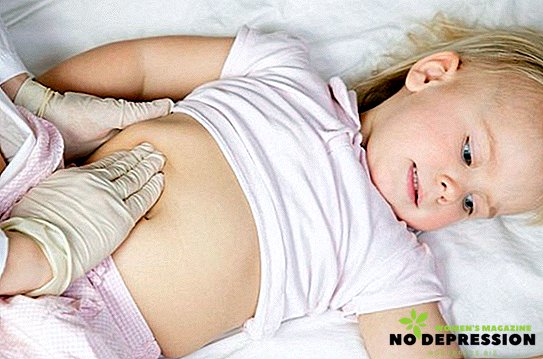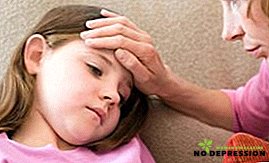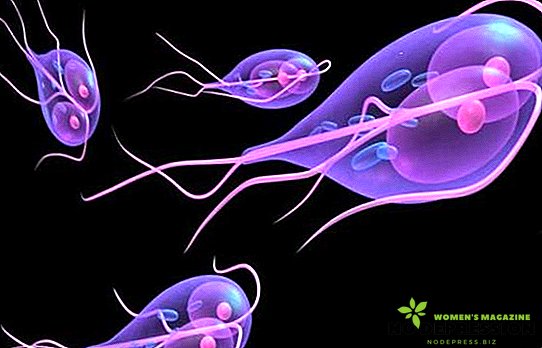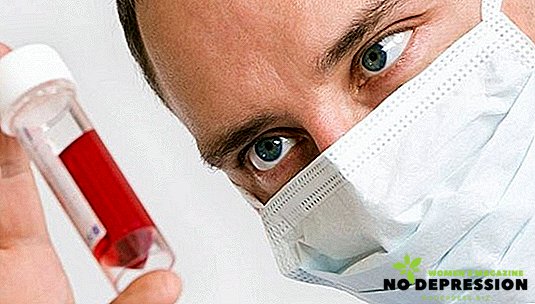Appendicitis in medicine is called the inflammation of the appendix. The disease belongs to dangerous pathologies, since it is difficult to diagnose, and if untimely treatment, dangerous complications develop. The signs of appendicitis in children differ from the symptoms of the disease in adults.

Features of appendicitis in children
Inflammation of the appendix can occur in children of different ages. The symptomatology of pathology is similar to the signs of many diseases of the gastrointestinal tract, including infectious ones. Therefore, it is difficult to diagnose the disease even to experienced doctors.
In addition, the symptoms of the disease in children depend on their age. For example, in infants, diarrhea is a sign, and in adolescents, on the contrary, constipation often occurs.
A feature of appendicitis in children is its rapid development. If you ignore the signs of the disease may cause dangerous complications.
The first signs of appendicitis
The first symptom of the pathology is acute pain in the navel zone.
 Which part of the abdomen it moves depends on the localization of the appendix:
Which part of the abdomen it moves depends on the localization of the appendix:
- normal placement of the appendix - pain in the lower right side;
- subhepatic location - pain in the hypochondrium on the right;
- pelvic location - pain in the suprapubic part of the abdomen, the child often urinates, diarrhea with mucus may occur;
- retrocycal localization (behind the rectum) - lumbar pain.
The classic manifestation of appendicitis is pain in the umbilical region, which goes down the right side of the abdomen. Near the navel, it is usually dull and aching, and after moving down it becomes intense, sharp and piercing.
At atypical locations of the appendix, other symptoms may occur (discomfort and pain in the groin area, problems with urination, strained abdomen). In such cases, a dangerous complication is the gangrenous form of inflammation of the appendix.
 Signs of inflammation of the appendix in children are also considered:
Signs of inflammation of the appendix in children are also considered:
- refusal to eat food;
- difficulty walking;
- heat;
- white bloom on the tongue;
- sharp pain in the stomach when jumping, coughing, riding.
Regarding the temperature, it rises to different marks depending on age. The highest is in children with appendicitis, subfebrile (not higher than 38 degrees) - in adolescence. At the same time, symptoms of respiratory diseases are not observed: cough, nasal congestion, runny nose, pain and redness in the throat.
A child with appendicitis may feel sick, often vomiting begins, which does not bring relief. Sometimes the pathology along with the above symptoms may be manifested by loose stools and constipation.
Another sign of appendicitis: if you lay the child in a supine position with the legs bent at the knees, then with a soft pressure on the right side, the pain subsides. If you sharply let go of your fingers, then there is an increase in pain.
If such symptoms are observed, it is better to show the child to the doctor.
How to recognize an attack in children under 3 years of age?
In children, it is especially difficult to determine the pathology, since they are not able to express their feelings. Appendicitis at this age is the most dangerous due to the sudden onset and rapid development. However, due to the anatomical features of the intestines and proper nutrition in young children, an appendix is extremely inflamed.
Usually at this age with appendicitis, the child is very restless: he presses his legs to his stomach, tries to lie on his left side, curled up. On palpation of the abdomen, children usually cry.

Signs of inflammation of the appendix at this age include:
- capriciousness;
- refusal to eat;
- tightening the legs to the stomach;
- anxiety;
- cry;
- frequent regurgitation;
- sleep disturbance;
- vomiting (usually multiple);
- nausea;
- pain when urinating;
- rapid pulse;
- reduced activity;
- pallor of the skin;
- hyperthermia - up to 40 degrees;
- dryness in the mouth;
- pallor of the tongue;
- loose stools with mucous discharge;
- general weakness.
In some cases, a child younger than three years of age has diarrhea or constipation. It is also important to note that in children who eat breast milk, the temperature usually does not rise above 37.5 degrees.
Signs of appendicitis in children 5 years
Preschooler children can not talk about abdominal discomfort for a long time, because they do not pay attention to the weak pain.
Symptoms of appendicitis in children from 3 to 5 years old include:
 abdominal pain;
abdominal pain;- delayed bowel movements;
- loss of appetite;
- increased pain when changing poses;
- bloating;
- increased gas production;
- irritability;
- heart palpitations;
- general weakness.
The temperature in children of this age with appendicitis rises to 38.5-39 degrees.
Symptoms of pathology in a child of school age
In schoolchildren, appendicitis is manifested by the same symptoms as in adult patients.
Typical signs of a pathological condition include:
- vomiting (can be double or single);
- increased low-grade fever (up to 38 degrees);
- loss of appetite;
- disturbed sleep;
- increased pain when bending forward;
- dry tongue and white plaque on it;
- pain in the lower abdomen.
Normal stool is usually observed. However, sometimes there are constipation or diarrhea.
Experts say that most often at this age with an inflamed appendix develop atypical symptoms:
- soreness in the back;
- epigastric discomfort;
- pain in the rectum.
The place of pain depends primarily on the localization of the appendix.
Signs of appendicitis in adolescents

Inflammation of the appendix, according to statistics, they occur more often than in young children.
One of the symptoms of the disease in adolescence is considered the syndrome of "toxic scissors." In this case, there is a discrepancy between the rapid pulse and body temperature.
Symptoms of appendicitis in children from 12 to 17 years old are:
- abdominal pain (localization depends on the location of appendicitis);
- temperature rise;
- single vomiting;
- constipation;
- weakness;
- raid on the tongue.
Treatment of appendicitis in children
Appendicitis is treated surgically - an appendectomy is performed. For this purpose, apply two methods of surgical intervention:
- open appendix removal (through an abdominal incision);
- laparoscopy (use of a special surgical instrument).
 The operation is performed under general anesthesia. It lasts from half an hour to sixty minutes.
The operation is performed under general anesthesia. It lasts from half an hour to sixty minutes.
After surgery in order to prevent the development of complications, antibacterial drugs are prescribed to the child.
After cuts and laparoscopy, the wound is daily treated with antiseptic solutions and a sterile dressing applied to it.
In addition, after surgery, you must comply with diet. Immediately after surgery, you can give your child some water to drink, starting with a drop and increasing to a teaspoon.
On the following day, low-fat kefir or weak broth is allowed.
Possible complications
If you ignore the signs of pathology in children, then life-threatening complications can quickly develop. The simple form of the disease rapidly develops into destructive appendicitis (gangrenous and phlegmonous).
Serious consequences of appendicitis are:
- appendicular peritonitis;
- intestinal obstruction;
- internal bleeding;
- perforation of the appendix wall;
- abscess appendicular;
- sepsis.
These consequences can be fatal, if they are not diagnosed in time and do not begin treatment. Sometimes periappendicular infiltrate develops, which becomes chronic. With timely treatment to the doctor and treatment, the risk of these complications is reduced several times. In this case, the prognosis is favorable.
Frequent diarrhea and vomiting with appendicitis in a child can result in dehydration.
The postoperative complications include the appearance of pus on the seams, problems with abdominal organs, subphrenic abscess.
Thus, appendicitis in children of different ages can manifest itself in different ways. Symptoms of pathology are similar to other diseases and poisoning. Inflammation of the appendix in childhood has its own characteristics and is fraught with the rapid occurrence of severe complications. Therefore, when signs of inflammation of the appendix appear, it is necessary not to hesitate, but to call for urgent help.


 abdominal pain;
abdominal pain;









